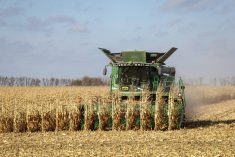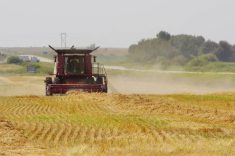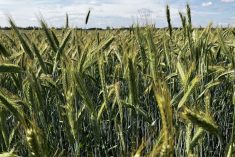Winter wheat is off to a good start in Manitoba, but the recent wet spell put a damper on weed control and let weeds like dandelions and cleavers get more foothold than producers would probably like.
That’s according to a May 21 webinar hosted by Manitoba Agriculture.
Winter wheat was generally average to above average going into the week, according to Lionel Kaskiw, a crop production specialist with Manitoba Agriculture. “There’s not much winter kill showing up in most areas,” he said.
Read Also

Time to be honest about hemp, experts say
Years of hype have given way to a more realistic view of hemp. Farmers and processors say the crop’s future depends on solid agronomy, honesty.
WHY IT MATTERS: Fields and wildfire areas in Manitoba needed rain earlier this month, and many areas got it in the second-last week of May, but that same pelting rain pumped the brakes on seeding and weed control.
Fields in Manitoba’s southwest are advancing well, thanks to a good supply of winter moisture and recent rain. Recent cooler temperatures have slowed some growth in that area, according to the May 21 crop report from Manitoba Agriculture.
In the northwest, winter wheat crops are also progressing well and are starting to tiller while, in the central region, the crop is growing rapidly, with most producers posting winter survival rates of 80 to 90 per cent.
Winter wheat is also looking good in eastern Manitoba with minimal winter kill. In the Interlake, the crop is already well established, and yield potential is promising, the report said.

Weed management challenges emerge
Many producers have been actively spraying their winter wheat crops, trying to control broadleaf weeds and large winter annuals like cleavers and dandelions, Kaskiw noted.
Cleavers in particular had grown to a point where they’re harder to control, especially where wet and windy conditions have prevented spraying.
“I think it’ll be top on the list for the next day, when you can start travelling in the field again, to try and at least set them back, or if not, get some of the smaller ones that are out there, but a lot of them are getting really big,” Kaskiw said May 21.
Dandelions are already flowering and have also become difficult to control, Kaskiw said.
“Those ones are going to be hard to set back as well.”
Cleaver management strategies
Cleavers reproduce by seed and prefer damp, moist soil—conditions that have been prevalent in many parts of Manitoba during the second half of May.
Cleavers also tend to be a problem in canola, Manitoba Agriculture’s website states. Their seeds are close enough to the oilseed that they’re hard to filter out. Cleavers at densities of 100 plants per square metre can result in yield reductions of 20 per cent in canola, Manitoba Agriculture’s website states.
Cleaver seeds can also go dormant in dry soil and remain viable for up to three years. Spread vectors include being eaten by animals, harvesting equipment and through contaminated manure. Since the seeds are bristly, they can also easily cling to the hair and wool of animals and to clothing.
Manitoba Agriculture recommends producers take a minimum of 20 weed counts across the field, taking care to check low spots for patches of cleavers.
The trailing way cleavers grow can prevent proper crop development, with their bristles also making crop handling and harvesting difficult. The extra green material can complicate straight cutting at harvest.
To keep on top of cleavers, it’s recommended that producers use certified seed and clean tillage and harvesting equipment before changing fields.
Annual cleavers can be controlled in the fall after germination with herbicide or via tillage. There are herbicide options against the weed in cereal crops, field peas, and herbicide-resistant canola varieties.

Dandelion control
Just like with cleavers, Manitoba Agriculture suggests that producers do 20 weed counts across a field, paying attention to edges, since weed seeds often blow in from nearby undeveloped areas, turf and shelterbelts.
Dandelions don’t normally affect the quality of forage crop, but can cause yield losses in annual and winter annual crops, as well as perennial forage seed crops, according to Manitoba Agriculture.
A glyphosate pass can knock back the problem, or deep tillage cutting the weed’s taproot 10 centimetres below the surface. Heavy-duty cultivators and deep tillers have the most success in removing the weed, while discers are often ineffective where stands are well established, farmers are advised.















